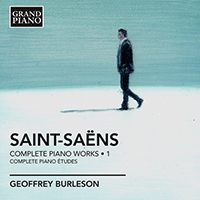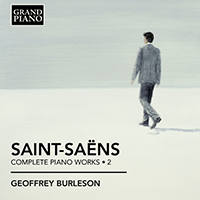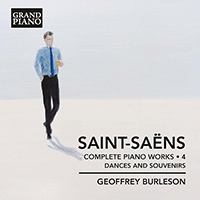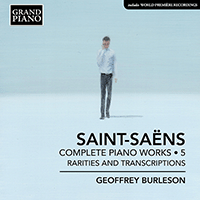
About this Release
“The breadth, brilliance and imagination of Saint-Saëns’ piano works never ceases to inspire me! The Op. 3 Six Bagatelles, his first published piano works, are fully mature, beautiful, richly inventive, and – with the final bagatelle – quite poignant. The Op. 72 Album includes movements that match the evocative mystery of late Liszt (“Carillon”), delicate ethereal writing that foreshadows the French Impressionist composers, and Saint-Saëns’ singular virtuosity. In his “Caprice” on Gluck’s Alceste, Saint-Saëns creates an astonishing variety of wrought moods from themes in Gluck’s opera. And the Rhapsodie d’Auvergne is endlessly evocative, explosive and engaging.” — Geoffrey Burleson
SAINT-SAËNS, CAMILLE (1835–1921)
Complete Piano Works • 3
Character Pieces
- Geoffrey Burleson, piano
Saint-Saëns’ first published works for piano were the vivid and characterful Six Bagatelles, Op. 3. Album, Op. 72 dates from his mid-career and teems with rich colours and textures – haunting and exciting alike. Elsewhere, in this third volume of the Complete Piano Music, we find the richly evocative tone poem Rhapsodie d’Auvergne, paraphrases, and some delicious encores. Camille Saint-Saëns was a piano prodigy, eulogised by Liszt amongst many others, one of the most exciting and imaginative of composers for the instrument, and a central figure in French Romanticism. His facility to evoke scenes, personalities and colours was profound and his very personal use of baroque and classical forms was ingeniously eventful.
Tracklist
|
6 Bagatelles, Op. 3 (1855) (00:16:00 )
|
|
1
Bagatelle No. 1: Poco sostenuto (00:02:29)
|
|
2
Bagatelle No. 2: Allegro animato quasi presto (00:03:10)
|
|
3
Bagatelle No. 3: Poco adagio (00:02:59)
|
|
4
Bagatelle No. 4: Moderato assai (00:02:10)
|
|
5
Bagatelle No. 5: Allegro molto (00:04:10)
|
|
6
Bagatelle No. 6: Poco sostenuto (00:05:56)
|
|
Album, Op. 72 (1884) (00:23:00 )
|
|
7
No. 1. Prelude (00:03:26)
|
|
8
No. 2. Carillon (00:04:26)
|
|
9
No. 3. Toccata (00:02:19)
|
|
10
No. 4. Valse (00:04:37)
|
|
11
No. 5. Chanson Napolitaine (00:03:49)
|
|
12
No. 6. Final (00:05:25)
|
|
13
Rhapsodie d'Auvergne, Op. 73 (1884) (00:09:53)
|
|
14
Caprice sur des airs de Ballet d'Alceste de Gluck (1868) (00:12:03)
|
|
15
Les cloches du soir in E-Flat Major, Op. 85 (1889) (00:03:14)
|
|
16
Romance sans paroles (1871) (00:02:04)
|
|
17
Feuillet d'album in A-Flat Major, Op. 169 (1921) (00:03:04)
|
The Artist(s)
 Geoffrey Burleson has performed to wide acclaim throughout Europe and North America, and is equally active as a recitalist, concerto soloist, chamber musician and jazz performer. His numerous acclaimed solo appearances include performances at prestigious venues. He has also appeared as featured soloist at the Mostly Modern, Bard Music, Monadnock, Mänttä and Santander Music Festivals, the Talloires International Festival in France and the International Keyboard Institute & Festival in New York.
Geoffrey Burleson has performed to wide acclaim throughout Europe and North America, and is equally active as a recitalist, concerto soloist, chamber musician and jazz performer. His numerous acclaimed solo appearances include performances at prestigious venues. He has also appeared as featured soloist at the Mostly Modern, Bard Music, Monadnock, Mänttä and Santander Music Festivals, the Talloires International Festival in France and the International Keyboard Institute & Festival in New York. The Composer(s)
 Once described as the French Mendelssohn, Camille Saint-Saëns was talented and precocious as a child, with interests by no means confined to music. He made an early impression as a pianist. Following established French tradition, he was for nearly 20 years organist at the Madeleine in Paris and taught briefly at the École Niedermeyer, where he befriended his pupil Gabriel Fauré. He was a co-founder of the important Société Nationale de Musique with the patriotic aim of promoting contemporary French music in the aftermath of the Franco-Prussian war of 1870-01, in which he had served in the Garde Nationale de la Seine. Prolific and versatile as a composer, he contributed to most genres of music, but by the time of his death in 1921 his popularity in France had diminished considerably, as fashions in music had changed.
Once described as the French Mendelssohn, Camille Saint-Saëns was talented and precocious as a child, with interests by no means confined to music. He made an early impression as a pianist. Following established French tradition, he was for nearly 20 years organist at the Madeleine in Paris and taught briefly at the École Niedermeyer, where he befriended his pupil Gabriel Fauré. He was a co-founder of the important Société Nationale de Musique with the patriotic aim of promoting contemporary French music in the aftermath of the Franco-Prussian war of 1870-01, in which he had served in the Garde Nationale de la Seine. Prolific and versatile as a composer, he contributed to most genres of music, but by the time of his death in 1921 his popularity in France had diminished considerably, as fashions in music had changed. Reviews
“Burleson rides the musical waves like a bronzed champion surfer.” – MusicWeb International
“All this music is played with verve and commitment by Burleson” – Gramophone
“The American pianist, Geoffrey Burleson, who has already given much pleasure in the series, is our reliable tour guide in excellent recorded sound.” – David’s Review Corner





 Grand Piano has gained a reputation for producing high quality recordings of rare keyboard gems. Dedicated to the exploration of undiscovered piano repertoire, the label specialises in complete cycles of piano works by many lesser-known composers, whose output might otherwise have remained unknown and unrecorded.
Grand Piano has gained a reputation for producing high quality recordings of rare keyboard gems. Dedicated to the exploration of undiscovered piano repertoire, the label specialises in complete cycles of piano works by many lesser-known composers, whose output might otherwise have remained unknown and unrecorded.






